Fast Facts on Weight Loss Surgeries
-

Approximately 200,000 US adults have bariatric (weight loss) surgery each year. There are several procedures available, each with its own set of risks and rewards. Some are restrictive, meaning they limit the amount of food you can consume at one time. Others are malabsorptive, meaning they work by reducing the absorption of calories, proteins and other nutrients in food. (Some are both restrictive and malabsorbtive.)
Here are some fast facts on the top weight loss procedures:
-
1. Gastric Bypass
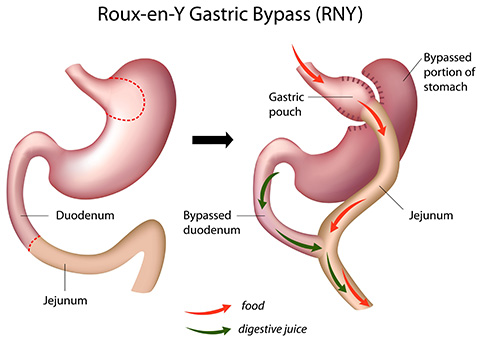
Type of surgery: Restrictive and malabsorptive
What happens: Your surgeon creates a small stomach pouch to curb food intake by stapling a part of the stomach. Part of the digestive system is bypassed so you don’t absorb as much food. There are several types of Roux-en-Y gastric bypass.
Time in Surgery: One to two hours, followed by one to seven days in hospital.
Results: Most of the weight loss occurs within one year.
Keep In Mind: Vitamin supplementation is needed to stave off any nutritional shortfalls.
Diabetes Cure? Possibly
-
2. Gastric Banding
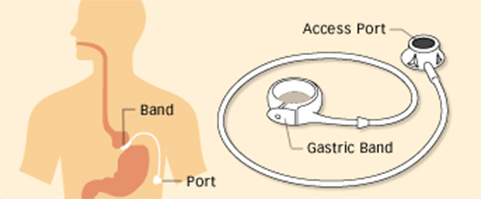
Type of surgery: Restrictive
What happens: A silicone band, such as the Lap-Band, is placed around the upper stomach to restrict food intake. There is no cutting or re-routing of the intestines involved. The band can be tightened or loosened to change the size of the passage and speed up weight loss.
Time in surgery: One to one and a half hours. It can be done on an outpatient basis.
Results: You may lose about five to 10 pounds a month and will likely lose two-thirds of excess weight within two years.
Keep In mind: Gastric banding is reversible and adjustable. It requires regular follow-up visits with the surgeon for fills.
Diabetes Cure? “Restrictive operations have lesser anti-diabetic effects mostly due to an overall calorie reduction and hopefully some element of weight loss,” says Joseph J. Colella, MD, FACS, a bariatric surgeon in Pittsburgh, PA and the author of The Appetite Solution: Lose Weight Effortlessly and Never Be Hungry Again.]
-
3. Gastric Sleeve Surgery
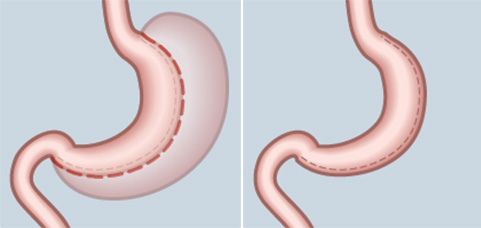
Type of surgery: Restrictive
What Happens: During this procedure, a surgeon removes about 85 percent of your stomach. What remains resembles a tube or sleeve. This operation is performed via small incisions as opposed to one large incision.
Time in Surgery: One to two hours.
Results: You can lose 50 to 80 percent of excess body weight in the first six to 12 months after surgery.
Keep in mind: It is non-reversible.
Diabetes Cure? “Restrictive operations have lesser anti diabetic effects mostly due to an overall calorie reduction and hopefully some element of weight loss,” says Dr. Colella.
-
4. Duodenal Switch
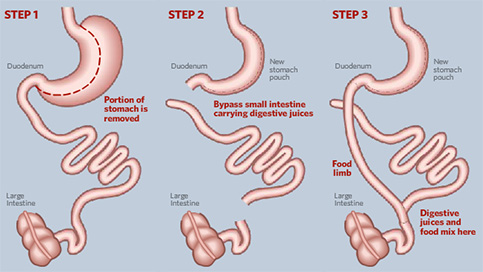
Type of surgery: Restrictive and malabsorbtive
What happens: First, the surgeon creates a smaller, tubular stomach pouch by removing some of the stomach, and then he or she bypasses a large part of the small intestine. The procedure is also known as vertical gastrectomy with duodenal switch, biliopancreatic diversion with duodenal switch, DS or BPD-DS.
Time in surgery: Three to four hours.
Results: You can expect to lose about 70 percent of your current weight and about 35 percent of your body mass index in the first 12 to 18 months after the surgery.
Keep In mind: This is the most complicated bariatric surgery, but also results in dramatic weight loss.
Diabetes Cure? Possibly
-
5. Cut-Free Weight Loss Surgeries

Type of surgery: Mainly restrictive
What happens: Many of today’s newer weight loss surgeries don’t involve any cutting all. Instead, surgeons use natural orifices — such as the throat — to insert the small surgical tools. One example is the gastric balloon. During gastric balloon, a deflated balloon is inserted into the stomach via the mouth and filled with liquid or air, reducing the amount of food a person can comfortably eat. The balloon can be left in place for up to six months. Another incisonless option — the EndoBarrier sleeve — lines the upper part of small intestine, mechanically bypassing the duodenum and the first part of the jejunum.
Time in surgery: Varies by procedure
Results: Varies by procedure
Keep in mind: “These procedures work by limiting the amount of food an individual can ingest in any one sitting,” says Dr. Colella.
Diabetes Cure? Jury out.
-
6. The Maestro Rechargeable System
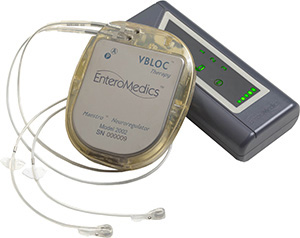
EnteroMedics VBLOC® vagal blocking therapy is delivered via a pacemaker like device called the Maestro® System. Image courtesy of EnteroMedics Inc.
Type of surgery: Pacemaker for the stomach
What happens: The Food and Drug Administration (FDA) recently approved the Maestro Rechargeable System. This is a new implantable weight loss device. A small disc is placed under the skin against the ribs, where it generates an electrical pulse that travels down wires implanted in the abdomen. The wires send signals that block the vagus nerve, which regulates feelings of hunger and fullness.
Time in Surgery: Up to 90 minutes.
Results: Most people lost an average of 25 percent of their excess weight in 12 months (and eight more pounds than a control group of people who had the device implanted but not activated), according to a study by the manufacturer.
Keep in mind: The new vagal blocking device is the first FDA-approved anti-obesity device since 2007.
Diabetes cure? Jury out. “If you eat less and lose weight you theoretically can have an impact on diabetes,” says Dr. Colella.
-
Summing It All Up

Each type of weight loss surgery has its own set of risks and benefits. Talk to a bariatric surgeon about which — if any — of the procedures best suits your needs and lifestyle. It is important to ask what type of follow-up care is involved, as well as to discuss the costs of the procedure. Many insurers help pay for weight loss surgery.







